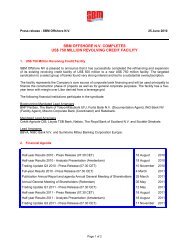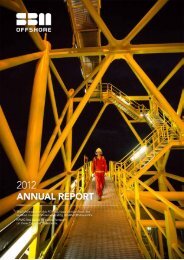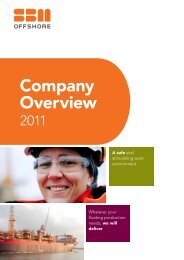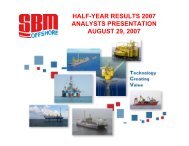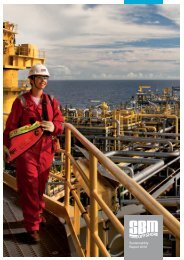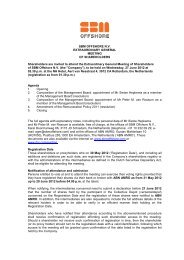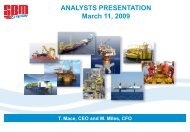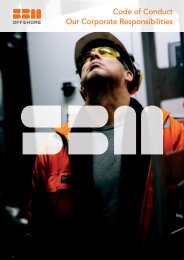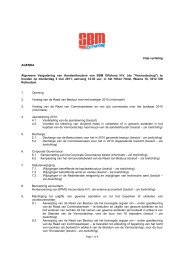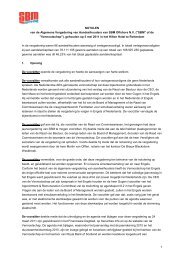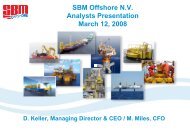1 DRAFT MINUTES of the Annual General Meeting ... - SBM Offshore
1 DRAFT MINUTES of the Annual General Meeting ... - SBM Offshore
1 DRAFT MINUTES of the Annual General Meeting ... - SBM Offshore
Create successful ePaper yourself
Turn your PDF publications into a flip-book with our unique Google optimized e-Paper software.
<strong>SBM</strong> would not be too dependent on one party. Finally, he referred to renewable energy, which everyone<br />
was in favour <strong>of</strong>. He asked (sixth question)<br />
when <strong>the</strong> first assignments for systems that take renewable<br />
energy from wave power or differences in temperature could be expected.<br />
The Chairman thanked Mr Jorna and gave <strong>the</strong> floor to Mr Mace.<br />
Mr Mace indicated that <strong>SBM</strong> sees quite good possibilities for future order intake in <strong>the</strong> near future, which<br />
would ensure a good backlog <strong>of</strong> work for several years ahead. <strong>SBM</strong> would take <strong>the</strong> opportunity to get <strong>the</strong><br />
right/best projects in <strong>the</strong> order portfolio going forward. He replied to <strong>the</strong> first question that <strong>the</strong> Company<br />
developed into such a size that it can handle around about ten to twelve major projects coincidentally, not<br />
all in parallel, but in <strong>the</strong> different project stages. However, <strong>the</strong> value <strong>of</strong> <strong>the</strong> projects increased dramatically<br />
as did <strong>the</strong>ir complexity. The Company makes steps to outsource in areas where <strong>the</strong>re are bottlenecks, such<br />
as engineering, in order to free up engineering resources. One <strong>of</strong> <strong>the</strong> key resources in <strong>the</strong> Company is <strong>the</strong><br />
engineering teams. The Company is taking steps to outsource detailed engineering in order to try to<br />
increase <strong>the</strong> volumumetric throughput, but realistically, this will not be a dramatic increase. <strong>SBM</strong> wants to<br />
make sure that it keeps control <strong>of</strong> its operations. As regards <strong>the</strong> second question in relation to <strong>the</strong><br />
agreement with Mitsubishi Corporation, Mr Mace that <strong>the</strong> large capex projects are increasing in size and, as<br />
announced, <strong>SBM</strong> has projects <strong>of</strong> over USD 1,000,000,000. In order to execute <strong>the</strong>se type <strong>of</strong> projects,<br />
provide <strong>the</strong> equity input whilst at <strong>the</strong> same time chasing several <strong>of</strong> <strong>the</strong>se projects, <strong>SBM</strong> needs financial<br />
support. <strong>SBM</strong> worked with Mitsubishi in <strong>the</strong> past on two previous contracts and knows <strong>the</strong>m. This was<br />
cemented in a new cooperation agreement under which Mitsubishi will provide equity to <strong>SBM</strong> on large<br />
projects, which <strong>the</strong> Company needs to be able to develop <strong>the</strong> business. Mr Mace indicated that Mitsubishi<br />
will not be involved in <strong>the</strong> actual work <strong>of</strong> building <strong>the</strong> projects, but are <strong>the</strong>re to provide financial support. Mr<br />
Mace stated that it is a good development and it helps <strong>SBM</strong> increasing <strong>the</strong> lease business. Mr Mace<br />
indicated in relation to <strong>the</strong> third remark that it is out <strong>of</strong> <strong>the</strong> control <strong>of</strong> <strong>the</strong> Company whe<strong>the</strong>r <strong>the</strong>re are lease<br />
projects or sale projects. <strong>SBM</strong> receives both types <strong>of</strong> orders for <strong>the</strong> larger FPSO's. The Company would<br />
generally prefer a balanced order intake, with a bit more <strong>of</strong> weighting on <strong>the</strong> side <strong>of</strong> lease. <strong>SBM</strong> tries to<br />
select projects which provided that balance, but this is not in <strong>the</strong> control <strong>of</strong> <strong>the</strong> Company. In relation to <strong>the</strong><br />
fourth question Mr Mace replied that LNG is an activity <strong>the</strong> Company entered into several years ago. The<br />
Company has gone through quite an exercise in 2007 and 2008 on developing a generic design <strong>of</strong> an LNG<br />
FPSO. Then came <strong>the</strong> economic crisis and <strong>the</strong>re was no movement on any LNG project during a period <strong>of</strong><br />
time. There now is growing momentum in LNG <strong>of</strong>fshore projects and <strong>SBM</strong> would be active on several <strong>of</strong><br />
<strong>the</strong>se. <strong>SBM</strong> is taking steps to be <strong>the</strong>re on <strong>the</strong> first projects and he indicated that <strong>the</strong>se would be big capex<br />
projects. Mr Mace stated that <strong>the</strong> large LNG FPSO projects certainly would be in <strong>the</strong> range <strong>of</strong> USD<br />
3,000,000,000. <strong>SBM</strong> decided to work in joint venture arrangements to share <strong>the</strong> costs on <strong>the</strong>se projects<br />
with o<strong>the</strong>r contracting companies. <strong>SBM</strong> intends to place itself in a position to be successful with this<br />
business when it grows. <strong>SBM</strong> was one <strong>of</strong> <strong>the</strong> initiators in developing an <strong>of</strong>fshore solution for LNG. One <strong>of</strong><br />
<strong>the</strong> components, which Mr Jorna referred to, is <strong>the</strong> ability to be able to <strong>of</strong>fload <strong>the</strong> LNG product <strong>of</strong>fshore<br />
safely. That piece <strong>of</strong> equipment was missing in <strong>the</strong> industry and that gap needed to be filled. <strong>SBM</strong> invested<br />
in an R&D program to develop a floating hose used to transfer <strong>the</strong> cryogenic liquid from <strong>the</strong> production<br />
vessel to an LNG carrier in a configuration which is safe to take place in <strong>the</strong> ocean. The only existing<br />
experience at <strong>the</strong> moment is <strong>the</strong> LNG carriers coming into a harbour and <strong>of</strong>floading alongside a quay. Mr<br />
Mace indicated that <strong>SBM</strong> was successful in developing <strong>the</strong> hose system and <strong>the</strong> <strong>of</strong>floading system required<br />
to make this whole FLNG FPSO system viable.<br />
Mr Mace replied in relation to Petrobras (fifth question) that <strong>SBM</strong> has a lot <strong>of</strong> business with Petrobras, but<br />
keeps track on a regular basis <strong>of</strong> <strong>the</strong> amount <strong>of</strong> risk effectively associated with <strong>the</strong> business ei<strong>the</strong>r in Brazil<br />
or with Petrobras. <strong>SBM</strong> makes sure that <strong>the</strong> level <strong>of</strong> business which it has in that country is comfortable. Mr<br />
Mace replied to <strong>the</strong> last question (sixth question) related to renewable energy initiatives, that <strong>the</strong> Company<br />
9



